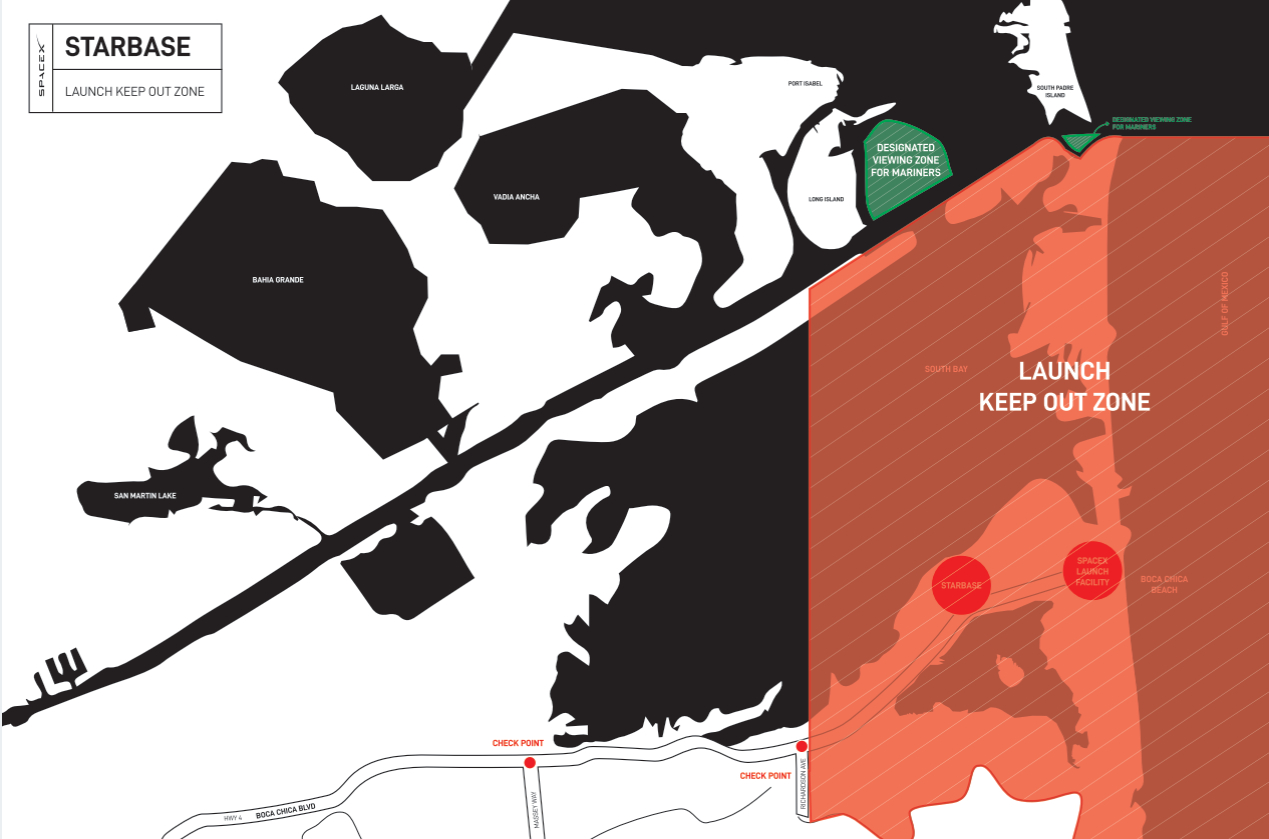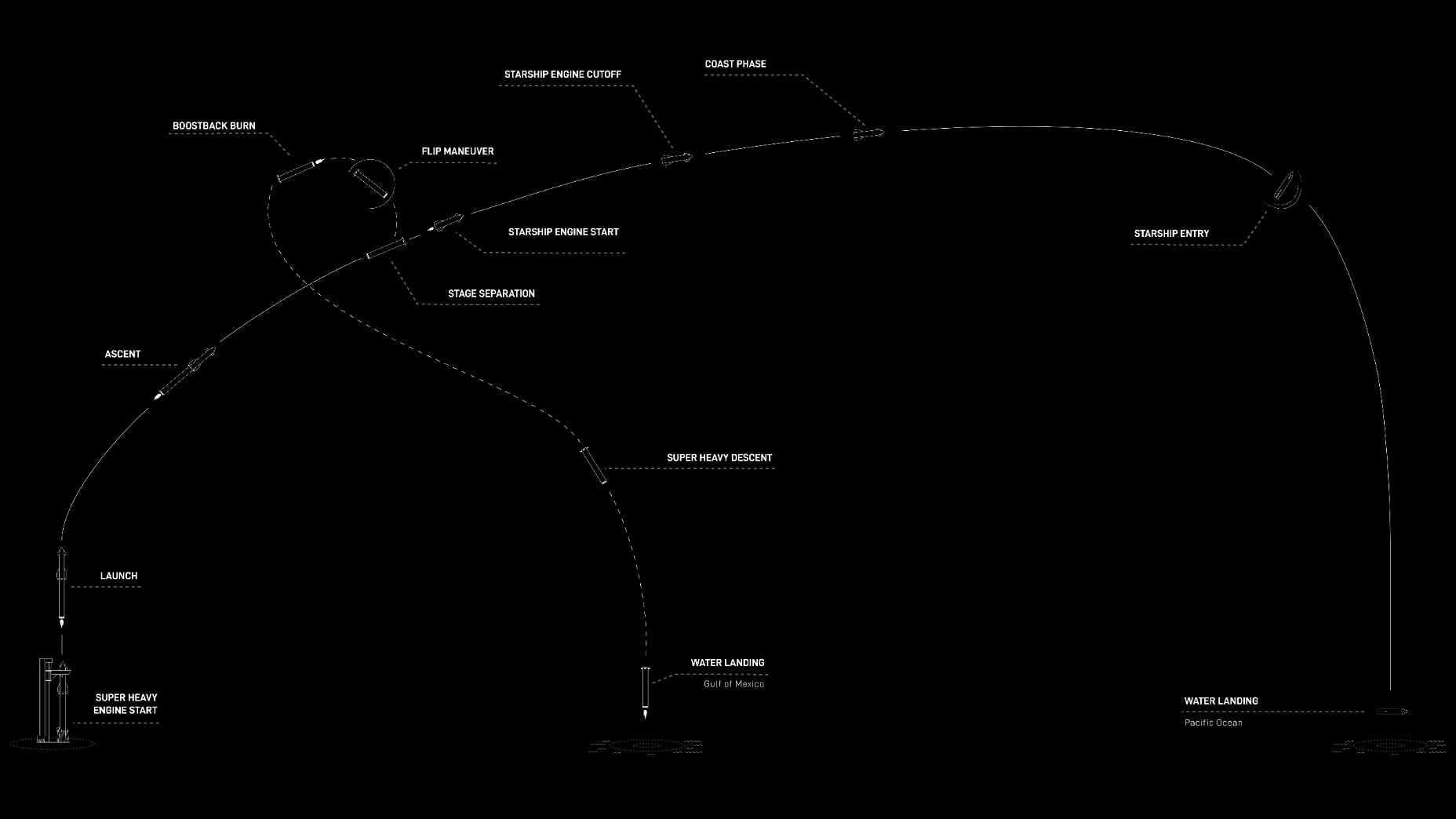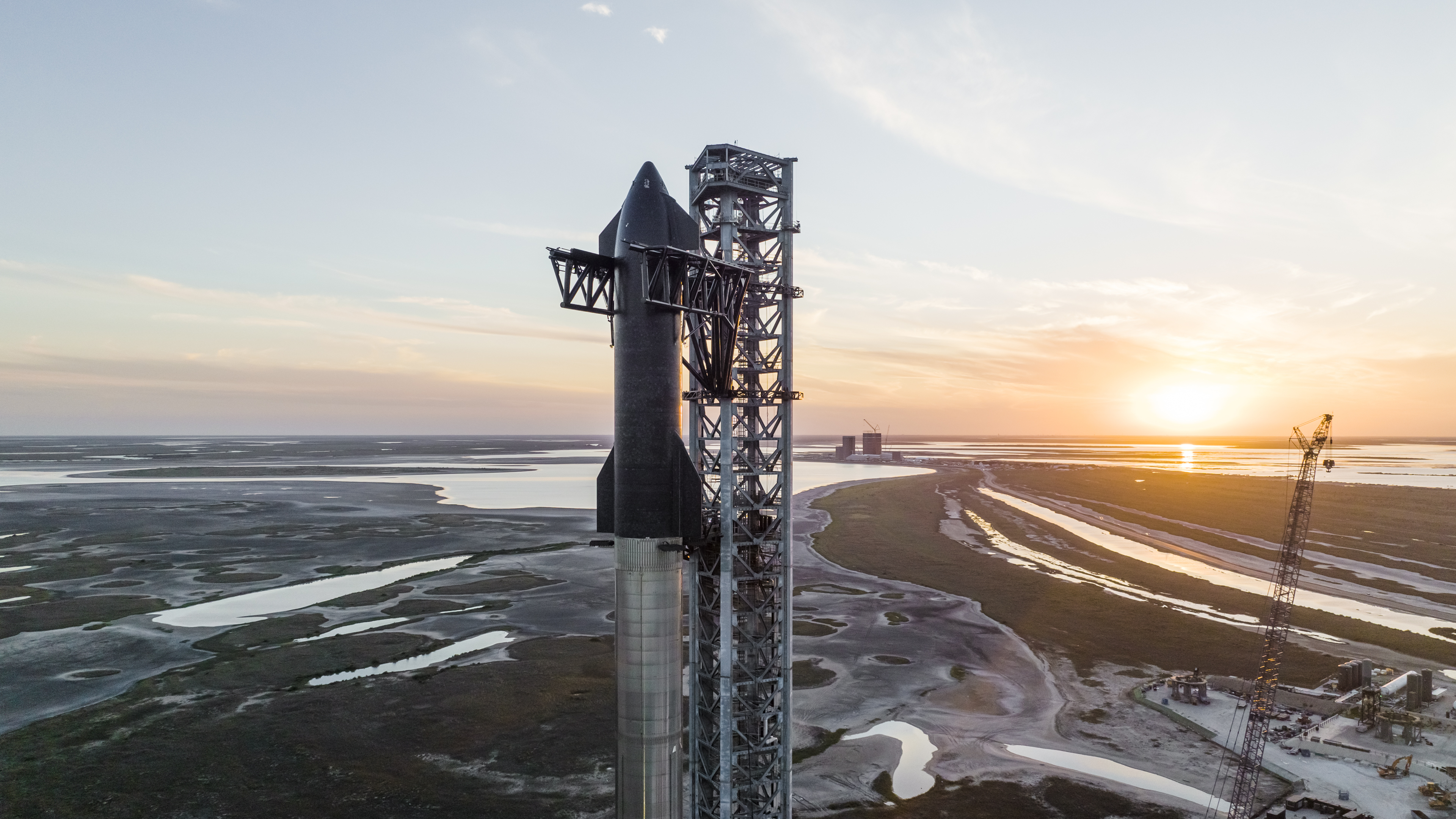What time is SpaceX's 1st Starship and Super Heavy launch today (April 20)?
SpaceX has a 62-minute window to launch the Starship SN24 spacecraft and Super Heavy rocket on April 20, starting at 9:28 a.m. EDT (1328 GMT).
Update for April 20 at 10:30 a.m. EDT (1430 GMT): SpaceX launched Starship on an epic test flight that ended in an explosive 'rapid unscheduled disassembly.' Read our post-flight coverage here.
SpaceX is counting down to its first ever launch of the world's biggest rocket, its towering Starship vehicle, on April 20, but exactly when the rocket will fly depends on several factors.
The first combined Starship spacecraft and Super Heavy booster are currently scheduled to launch from SpaceX's Starbase facility in Boca Chica, Texas no earlier than Monday at 9:28 a.m. EDT (1328 GMT). It will be 8:28 a.m. local time at the launch time. But whether SpaceX actually targets that time or opts to wait until later in the window remains to be determined. Here's a look at what time the mission is expected to fly.
Related: How to watch SpaceX's its 1st Starship launch on April 17
More: How SpaceX's 1st Starship space launch will work
What time is SpaceX's Starship launch?
SpaceX is currently targeting April 20 at 9:28 a.m. EDT (8:28 a.m. CDT/1328 GMT) to launch Starship and Super Heavy, but that may not be when the rocket actually lifts off. Indeed, a launch attempt on April 17 was scrubbed due to a fueling issue.
This is the first full flight test of a combined Starship and Super Heavy, which together stand 395 feet tall (120 meters). SpaceX aims to use as a fully reusable launch system for missions to the moon and Mars. NASA has picked Starship to be the moon lander astronauts will use on the Artemis 3 mission in 2025, the first crewed landing on the moon since 1972. But first, SpaceX has to perfect the design, which is what this first flight test will help do.
According to SpaceX's mission plan, Starship and Super Heavy has a 62-minute window in which to lift off from Starbase. That puts the launch attempt for anytime between 9:28 a.m. and 10:30 a.m. EDT (8:28-9:30 a.m. CT/1328-1430 GMT).
Get the Space.com Newsletter
Breaking space news, the latest updates on rocket launches, skywatching events and more!
Exactly when SpaceX will target the launch within that window will depend on the readiness of Starship and Super Heavy, the weather conditions at the launch site and if the launch "keep-out" zone is clear of ships offshore as a safety precaution.
If SpaceX does change the launch time before its webcast begins, the company will likely share a new T-0 time via Twitter and other channels as it has done for Falcon 9 rocket launches. So keep a close watch on the SpaceX Twitter feed for those updates.
Can I watch SpaceX's Starship launch?
Yes, you can watch SpaceX's first Starship launch.
SpaceX will provide a live webcast of the launch beginning about 45 minutes before liftoff. The webcast, which is embedded on this page, is currently expected to begin at 8:45 a.m. EDT (1245 GMT) for an 9:28 a.m. EDT (1328 GMT) liftoff.
IMPORTANT NOTE: That start time could change, however, if SpaceX moves its target launch time deeper into the window.
Several other SpaceX-watching sites will offer wider commentary with their own livestream services. One site to follow is NASASpaceflight.com, which regularly offers its own livestreams of Starship testing activities at the Starbase facility. NSF will likely have extensive YouTube livestream coverage in the hours before SpaceX's own webcast.
For Falcon 9 rocket launches, SpaceX has typically provided an audio-only YouTube feed from its launch control center. If the company does provide a similar feed for Starship, you'll be able to listen in on the launch team via a separate SpaceX feed on its YouTube channel.
The launch countdown timeline begins about two hours before launch, with SpaceX's flight director conducting a poll for propellant load.

If you are in the Boca Chica area and hoping to view the launch, you do have some options.
SpaceX has set aside two launch viewing sites for mariners in the waters near Long Island and South Padre Island. SpaceX's own viewing zone will be on South Padre Island in the Cameron County amphitheater. Where ever you decide to try and view the launch from, plan to arrive early and bring water, sunscreen and bug spray if you're outside.
How long is SpaceX's 1st Starship flight?

From launch to splashdown, SpaceX's first Starship test flight will last about 90 minutes.
Starship will not reach orbit on this mission. Instead, it should reach an altitude of about 146 miles (234 kilometers), circle most of the Earth and splash down in the Pacific Ocean about 140 miles (225 km) from the coast of Oahu, Hawaii. The Super Heavy booster, meanwhile, will make its own return trip to splash down in the Gulf of Mexico about 20 miles (32 km) from Boca Chica Beach.
SpaceX will not attempt to recover Starship or the Super Heavy booster. The company hopes to demonstrate a "soft-landing" of the Super Heavy, with it hovering over the ocean before splashdown. SpaceX performed similar soft landings with Falcon 9 boosters during landing tests for that smaller rocket.
| TIME (Hr:Min:Sec) | EVENT | Header Cell - Column 2 |
|---|---|---|
| T-2:00:00 | Flight director poll for fuel loading | Row 0 - Cell 2 |
| T-1:39:00 | Super Heavy liquid oxygen/liquid methane loading begins | Row 1 - Cell 2 |
| T-1:22:00 | Starship liquid methane loading begins | Row 2 - Cell 2 |
| T-1:17:00 | Starship liquid oxygen loading begins | Row 3 - Cell 2 |
| T-00:16:40 | Super Heavy Raptor engine chilldown | Row 4 - Cell 2 |
| T-00:00:40 | Fluid interfaces begin ventdown sequence | Row 5 - Cell 2 |
| T-00:00:08 | Raptor engine startup begins | Row 6 - Cell 2 |
| T-00:00:00 | Liftoff ("Excitement Guaranteed," as SpaceX puts it.) | Row 7 - Cell 2 |
| TIME (Hr:Min:Sec) | FLIGHT EVENT | Header Cell - Column 2 |
|---|---|---|
| T-00:00 | Liftoff | Row 0 - Cell 2 |
| 00:55 | Starship/Super Heavy reach Max Q | Row 1 - Cell 2 |
| 2:49 | Super Heavy main engine cutoff | Row 2 - Cell 2 |
| 2:53 | Stage separation | Row 3 - Cell 2 |
| 2:57 | Starship engine ignition | Row 4 - Cell 2 |
| 3:11 | Super Heavy boostback burn | Row 5 - Cell 2 |
| 7:32 | Super Heavy is transonic | Row 6 - Cell 2 |
| 7:40 | Super Heavy landing burn | Row 7 - Cell 2 |
| 8:03 | Super Heavy landing burn shutdown | Row 8 - Cell 2 |
| 9:20 | Starship engine cutoff | Row 9 - Cell 2 |
| 1:17:21 | Starship reentry | Row 10 - Cell 2 |
| 1:28:43 | Starship is transonic | Row 11 - Cell 2 |
| 1:30:00 | Starship splashdown | Row 12 - Cell 2 |
What if Starship can't launch?

If SpaceX cannot launch its Starship test flight on April 20, the company could try again later in the week depending on the nature of the scrub.
Officials with Cameron County, the Texas county that includes SpaceX's Starbase facility at Boca Chica beach, have released a beach closure advisory that stated that SpaceX had set aside April 18 and April 19 as backup dates for the launch.
However, if SpaceX does fully fuel the towering Starship and Super Heavy booster and then scrub the launch, that could cause additional down time as the company amasses more liquid oxygen and liquid methane propellant for the next try. In the past, the company has said it could take a few days to do so.
If there is a technical issue during the launch countdown or an abort that requires repairs, that could cause a more lengthy delay for Starship. SpaceX's launch license for this Starship test flight does last for five years, according to the Federal Aviation Administration, giving the company substantial cushion on the regulation end for additional attempts.
Editor's note: Tune in to Space.com on Thursday, April 28, to watch SpaceX's first-ever Starship launch at 9:28 a.m. EDT (1328 GMT). The live webcast is expected to start at 8:45 a.m. EDT (1245 GMT).
This story was updated April 18 at 8:50 a.m. to indicate the new launch time.
Email Tariq Malik at tmalik@space.com or follow him @tariqjmalik. Follow us @Spacedotcom, Facebook and Instagram.
Join our Space Forums to keep talking space on the latest missions, night sky and more! And if you have a news tip, correction or comment, let us know at: community@space.com.

Tariq is the Editor-in-Chief of Space.com and joined the team in 2001, first as an intern and staff writer, and later as an editor. He covers human spaceflight, exploration and space science, as well as skywatching and entertainment. He became Space.com's Managing Editor in 2009 and Editor-in-Chief in 2019. Before joining Space.com, Tariq was a staff reporter for The Los Angeles Times covering education and city beats in La Habra, Fullerton and Huntington Beach. In October 2022, Tariq received the Harry Kolcum Award for excellence in space reporting from the National Space Club Florida Committee. He is also an Eagle Scout (yes, he has the Space Exploration merit badge) and went to Space Camp four times as a kid and a fifth time as an adult. He has journalism degrees from the University of Southern California and New York University. You can find Tariq at Space.com and as the co-host to the This Week In Space podcast with space historian Rod Pyle on the TWiT network. To see his latest project, you can follow Tariq on Twitter @tariqjmalik.
-
danR There are other live streamers for the event besides NSF. LabPadre has been providing live cam action at the Boca Chica site before anyone else, and currently offers over half a dozen streams in real time.Reply









